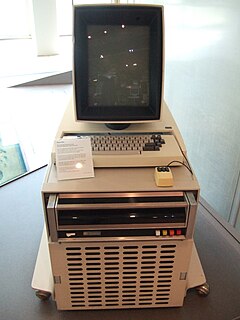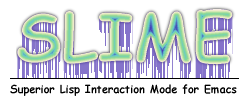Related Research Articles
Common Lisp (CL) is a dialect of the Lisp programming language, published in ANSI standard document ANSI INCITS 226-1994 (S20018). The Common Lisp HyperSpec, a hyperlinked HTML version, has been derived from the ANSI Common Lisp standard.

Lisp is a family of programming languages with a long history and a distinctive, fully parenthesized prefix notation. Originally specified in 1958, Lisp is the second-oldest high-level programming language. Only Fortran is older, by one year. Lisp has changed since its early days, and many dialects have existed over its history. Today, the best-known general-purpose Lisp dialects are Racket, Common Lisp, Scheme, and Clojure.

Lisp machines are general-purpose computers designed to efficiently run Lisp as their main software and programming language, usually via hardware support. They are an example of a high-level language computer architecture, and in a sense, they were the first commercial single-user workstations. Despite being modest in number Lisp machines commercially pioneered many now-commonplace technologies, including effective garbage collection, laser printing, windowing systems, computer mice, high-resolution bit-mapped raster graphics, computer graphic rendering, and networking innovations such as Chaosnet. Several firms built and sold Lisp machines in the 1980s: Symbolics, Lisp Machines Incorporated, Texas Instruments, and Xerox. The operating systems were written in Lisp Machine Lisp, Interlisp (Xerox), and later partly in Common Lisp.
In processor design, microcode is a technique that interposes a layer of computer organization between the central processing unit (CPU) hardware and the programmer-visible instruction set architecture of a computer. Microcode is a layer of hardware-level instructions that implement higher-level machine code instructions or internal finite-state machine sequencing in many digital processing elements. Microcode is used in general-purpose central processing units, although in current desktop CPUs, it is only a fallback path for cases that the faster hardwired control unit cannot handle.
Symbolics is a defunct computer manufacturer Symbolics, Inc., and a privately held company that acquired the assets of the former company and continues to sell and maintain the Open Genera Lisp system and the Macsyma computer algebra system.

In computer science, an interpreter is a computer program that directly executes instructions written in a programming or scripting language, without requiring them previously to have been compiled into a machine language program. An interpreter generally uses one of the following strategies for program execution:
- Parse the source code and perform its behavior directly;
- Translate source code into some efficient intermediate representation or object code and immediately execute that;
- Explicitly execute stored precompiled bytecode made by a compiler and matched with the interpreter Virtual Machine.
Kent M. Pitman (KMP) is a programmer who has been involved for many years in the design, implementation, and use of systems based on the programming languages Lisp and Scheme. Since 2010, he has been President of HyperMeta, Inc.

The Xerox Alto is the first computer designed from its inception to support an operating system based on a graphical user interface (GUI), later using the desktop metaphor. The first machines were introduced on 1 March 1973, a decade before mass-market GUI machines became available.
Interlisp is a programming environment built around a version of the programming language Lisp. Interlisp development began in 1966 at Bolt, Beranek and Newman in Cambridge, Massachusetts with Lisp implemented for the Digital Equipment Corporation (DEC) PDP-1 computer by Danny Bobrow and D. L. Murphy. In 1970, Alice K. Hartley implemented BBN LISP, which ran on PDP-10 machines running the operating system TENEX. In 1973, when Danny Bobrow, Warren Teitelman and Ronald Kaplan moved from BBN to the Xerox Palo Alto Research Center (PARC), it was renamed Interlisp. Interlisp became a popular Lisp development tool for artificial intelligence (AI) researchers at Stanford University and elsewhere in the community of the Defense Advanced Research Projects Agency (DARPA). Interlisp was notable for integrating interactive development tools into an integrated development environment (IDE), such as a debugger, an automatic correction tool for simple errors (via do what I mean software design, and analysis tools.
CMUCL is a free Common Lisp implementation, originally developed at Carnegie Mellon University.

The PERQ, also referred to as the Three Rivers PERQ or ICL PERQ, was a pioneering workstation computer produced in the late 1970s through the early 1980s. In June 1979, the company took its very first order from the UK's Rutherford Appleton Laboratory and the computer was officially launched in August 1979 at SIGGRAPH in Chicago. It was the first commercially produced personal workstation with a Graphical User Interface. The design was heavily influenced by the original workstation computer, the Xerox Alto, which was never commercially produced. The origin of the name "PERQ" was chosen both as an acronym of "Pascal Engine that Runs Quicker," and to evoke the word perquisite commonly called perks, that is employee additional benefits.
Lisp Machines, Inc. was a company formed in 1979 by Richard Greenblatt of MIT's Artificial Intelligence Laboratory to build Lisp machines. It was based in Cambridge, Massachusetts.
*Lisp is a programming language, a dialect of the language Lisp. It was conceived of in 1985 by two employees of the Thinking Machines Corporation, Cliff Lasser and Steve Omohundro, as a way to provide an efficient yet high-level language for programming the nascent Connection Machine (CM).

Steel Bank Common Lisp (SBCL) is a free Common Lisp implementation that features a high-performance native compiler, Unicode support and threading.
Hemlock is a free Emacs text editor for most POSIX-compliant Unix systems. It follows the tradition of the Lisp Machine editor ZWEI and the ITS/TOPS-20 implementation of Emacs, but differs from XEmacs or GNU Emacs, the most popular Emacs variants, in that it is written in Common Lisp rather than Emacs Lisp and C—although it borrows features from the later editors. Hemlock was originally written by the CMU Spice project in Spice Lisp for the PERQ computer.
Dylan programming language history first introduces the history with a continuous text. The second section gives a timeline overview of the history and present several milestones and watersheds. The third section presents quotations related to the history of the Dylan programming language.

SLIME, the Superior Lisp Interaction Mode for Emacs, is an Emacs mode for developing Common Lisp applications. SLIME originates in an Emacs mode called SLIM written by Eric Marsden. It is developed as an open-source public domain software project by Luke Gorrie and Helmut Eller. Over 100 Lisp developers have contributed code to SLIME since the project was started in 2003. SLIME uses a backend called Swank that is loaded into Common Lisp.
VAX LISP was an implementation of Common Lisp for VMS and ULTRIX on 32-bit VAXs. It was the first Common Lisp to be written for non-Lisp machines. It was initially boot-strapped from Carnegie Mellon University's Spice Lisp by recompiling its output but for VAX machine instruction and to use the large VAX stack. Some of the original developers came from CMU.
Rekursiv was a computer processor designed by David M. Harland in the mid-1980s at a division of hi-fi manufacturer Linn Products. It was one of the few computer architectures intended to implement object-oriented concepts directly in hardware, a form of high-level language computer architecture. The Rekursiv operated directly on objects rather than bits, nibbles, bytes and words. Virtual memory was used as a persistent object store and unusually, the processor instruction set supported recursion.
A high-level language computer architecture (HLLCA) is a computer architecture designed to be targeted by a specific high-level programming language (HLL), rather than the architecture being dictated by hardware considerations. It is accordingly also termed language-directed computer design, coined in McKeeman (1967) and primarily used in the 1960s and 1970s. HLLCAs were popular in the 1960s and 1970s, but largely disappeared in the 1980s. This followed the dramatic failure of the Intel 432 (1981) and the emergence of optimizing compilers and reduced instruction set computer (RISC) architectures and RISC-like complex instruction set computer (CISC) architectures, and the later development of just-in-time compilation (JIT) for HLLs. A detailed survey and critique can be found in Ditzel & Patterson (1980).
References
- ↑ Gabriel, Richard P. (May 1985). Performance and evaluation of Lisp systems (PDF). MIT Press; Computer Systems Series. ISBN 0-262-07093-6. LCCN 85-15161.
- ↑ "CMUCL history".